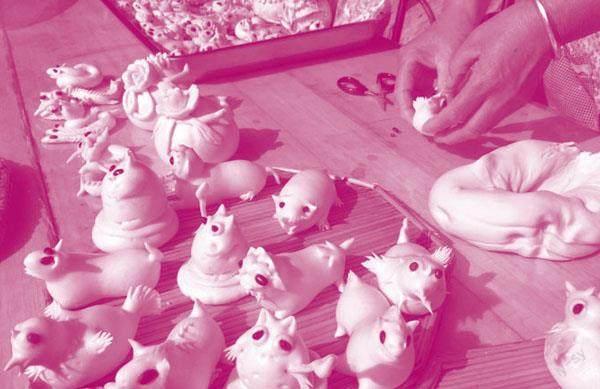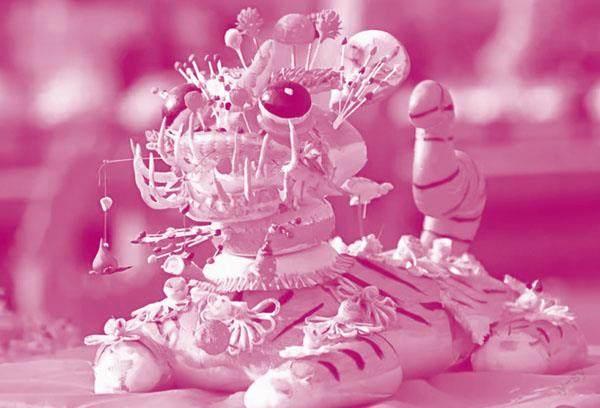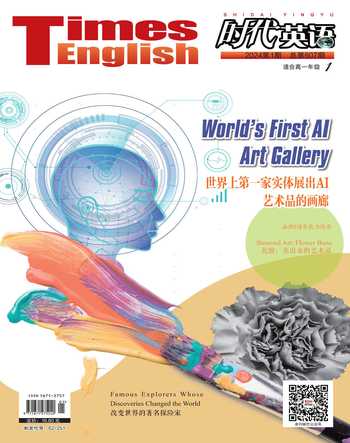Steamed Art: Flower Buns 花馍:蒸出来的艺术品
2024-03-03




North China has been the wheat production area since the ancient era. People there have long been experts in transforming the wheat flour into various kinds of wheaten food, the most typical of which is the bun. The bun, also called “the steamed bun”, is a traditional staple food in north China. People there also have long been making buns of various shapes and colors to express their aspirations and best wishes. They call those buns “flower buns”.
Flower buns originated from the change of Chinese folk custom on sacrifice, in which people replaced slaughtered cattle and sheep with dough made animals as sacrifices. With their vivid appearance, flower buns are especially popular in the Yellow River Region in general and provinces like Shanxi, Shaanxi, Shandong and Henan in particular.
Flower buns can fulfill food, visual and etiquette functions. For generations, people along both banks of the Yellow River have been subtly expressing their feelings and emotions through flower buns. And flower buns are an art by women indeed. Usually women gather together to make flower buns whenever there is a big day or event.
中国北方自古以来就是小麦产区。北方人很早就擅长将小麦粉做成各种小麦食品,其中最典型的就是馍。馍又称“蒸馍”,是北方的传统主食。长期以来,那里的人们制作形色各异的馍,以表达自己的愿望和祝福。他们称这些馍为“花馍”。
花馍起源于中国民间祭祀活动中用面塑动物代替宰杀牛羊作为祭品的习俗。花馍以其生动的造型,在黄河流域尤为流行,特别是山西、陕西、山东和河南等省份。
花馍可食、可看、可用。世世代代,黄河两岸的人们通过花馍巧妙地表达自己的情感。事实上,花馍是女性们巧手制作的艺术品。每逢重大节日或活动,女性们都会聚在一起做花馍。
One of the most famous flower buns in China is “Wenxi Flower Buns” of Wenxi County, Shanxi Province. Particularly popular during the Ming and Qing dynasties, “Wenxi Flower Buns” have a history of over 1,300 years, famous for their unique artistic characteristics and sophisticated making processes. “Wenxi Flower Buns” were included in the list of Chinese Intangible Cultural Heritage in 2008.
Making “Wenxi Flower Buns” takes 4 to 5 days on average and goes through 9 major procedures and 100-plus minor procedures. All of these procedures have to be done manually. By using tools including scissors, chopsticks and combs, Wenxi people can make various shapes like flowers, fruits, figures, birds and beasts. Flower buns can be decorated with rice, beans and dates, sometimes colored with food dyes.
Different flower buns are made for different festivals with specific functions. Big flower buns are generally prepared for the Spring Festival. Shapes of buns for the Lantern Festival include lamps, dogs, roosters and pigs, etc. A married daughter should make fish-shaped buns for her original family, praying for a big harvest. In contrast, a family will make tiger head-shaped buns when wedding their daughter. Snake-shaped buns will be prepared for the Tomb Sweeping Day, with a connotation of wiping out all misfortunes. When the birthday of a senior family member is coming, people will make big peach-shaped buns as a celebration.
中国极有名的花馍之一是山西省闻喜縣的“闻喜花馍”。闻喜花馍在明清时期特别流行,至今已有1300多年的历史,它以独特的艺术性和精巧的制作过程而闻名遐迩。2008年,闻喜花馍被列入中国非物质文化遗产名录。
制作闻喜花馍平均需要四到五天,要经过9道大工序和100多道小工序,全靠手工揉捏,通过使用剪刀、筷子、梳子等工具辅助而成。闻喜人可以做出花朵、水果、人物、鸟兽等各种造型的花馍。花馍可以用大米、豆子和红枣装饰,有时也用食用色素着色。
根据其特定的用途,不同的节日会制作不同的花馍。大花馍一般是为春节准备的。元宵节有灯、狗、公鸡和猪等造型的花馍。出嫁的女儿要为娘家做鱼形花馍,祈求五谷丰登,而嫁女儿的人家则要做虎头花馍。蛇形花馍则是为清明节准备的,寓意消除一切不幸。家中长辈过生日时,人们会做桃形大花馍以示庆祝。
Word Bank
era /'ɪərə/ n. 时代;年代
When she left the firm, it was the end of an era.
staple /'steɪpl/ n. 基本食物;主食
sacrifice /'sækrɪfaɪs/ n. 祭祀;祭品
connotation /'kɒnə'teɪʃn/ n. 含义;隐含意义
